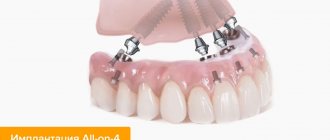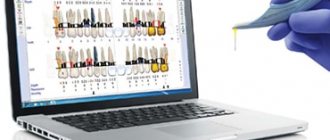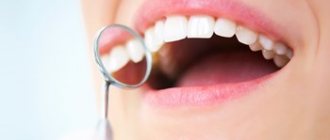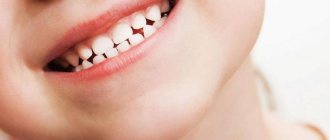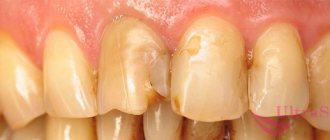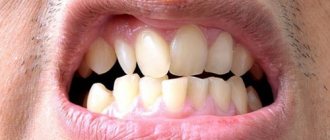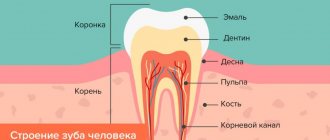Why are teeth bad?
Everyone has friends who are concerned about the health of their teeth, but at the same time do not get out of the dentist's chair, while others forget to brush them and are not familiar with the drill.
Alas, healthy teeth are largely the result of genetics, which can sometimes make up for even insufficient care and poor nutrition. Although “a mouth full of teeth” is still more common among those who brush them twice a day, undergo professional cleaning every year, do not overindulge in sweets, and heal caries in a timely manner. After all, in a person who has bad teeth from birth, even a small hole in a couple of months can turn into a huge cavity that destroys the tooth beyond the possibility of restoration.
Click to enlarge
Ideal teeth size
In dentistry, teeth of a certain size and anatomical shape are considered normal, depending on the size of the jaw and their location in it. They must be smooth, fit tightly to each other and have a thickness within certain limits: for example, the height of the lateral incisors in an adult is normally 7 - 11 millimeters. Of course, this does not mean that they need to be measured with a ruler - overall aesthetics and proportionality are much more important (for example, for people of short stature and fragile build, a small teeth size is appropriate). Many parents are interested in why their child has small teeth, but usually there is no reason to worry: normally, the baby incisors are small and located at a distance from each other.
However, if the patient really has very small teeth, you should definitely consult a dentist to confirm or exclude the diagnosis of microdentia.
How an implant becomes yours
Although the implantation technique was developed back in the 1970-1980s, many put up with the absence of teeth, believing that implants are painful, expensive and unreliable. According to statistics, 96% of operated patients use the same implants for more than 25 years. They can be installed in 20–30 minutes and are no more painful than removal. Artificial teeth are not cheap, but long-term treatment of hopeless teeth is even more expensive. The problem is that between tooth extraction and installation of a crown on an implant, an average of 2–3 months passes. But for this period, temporary crowns can be made. The main advantage of implants is that they completely restore chewing function, preserve adjacent teeth, and do not develop caries.
Back to the past. Outdated methods of dental treatment that it’s time to forget about Read more
How and why baby teeth grow
Our physiology normally provides for the replacement of baby teeth with molars, starting at about the age of five, and the process can be completed already during adolescence, up to sixteen years. By the way, it is interesting that, according to the observations of scientists, the age of replacement of baby teeth has recently shifted towards younger than a couple of decades ago. However, for some, the baby tooth is able to remain in place into adulthood, and even into old age! Why doesn't it fall out?
The baby tooth should fall out after its root resolves, and the molar begins to grow from below to replace it. Usually this process begins 2-3 years after the final formation of the baby tooth. But it also happens that molars are late in formation or do not appear at all. This can happen due to a number of factors - for example, heredity, metabolic or endocrine system disorders, jaw injury, etc. Inflammatory processes that once arose in baby teeth and were not treated in time can also affect this outcome. And the rudiments of molars can still form, but they are located so deep in the jaw tissue that they simply do not “reach” the milk teeth to push them out.
One day dentistry
Just a few years ago (and in some clinics even now), installing crowns took at least a month and required 4–6 visits to the dentist. Modern computer technologies make it possible to do this in 1–3 visits to the doctor. Dental impressions are becoming a thing of the past. Now, using an optical digital scanner, in 5-10 minutes the doctor receives a digitized image of the dentition, which is sent to a machine - a Triumfus multi-axis processing center (the latest development of the military-industrial complex together with dentists), on which the crown is machined automatically in 14-16 minutes. The machine can produce 200 crowns per load. The development marked the beginning of a new industry - dental machine tools. Work on it can be carried out at night and on weekends without human intervention. Thanks to this, one-day dentistry arose.
A milk tooth in an adult: to remove or not?
If a baby tooth has not fallen out, is susceptible to caries or interferes with the growth of a molar, this does not mean that it is doomed to be removed. Dentists still recommend taking care of it and extending its service life for you, curing it if necessary. If only because there is no guarantee that the root one will then grow in place of the removed milk one, even if its rudiments are discovered.
To make a final decision about baby teeth in adults, it is necessary to take an x-ray. The image will allow the doctor to understand whether at least some rudiments of the molar tooth have formed, as well as in what condition the roots of the milk tooth are - whether they are resolving or not. If there are no buds and the roots are not going to resolve, removal is contraindicated. If the roots have resolved and the tooth is wobbly, then most likely it will have to be removed and you will have to wonder about the optimal prosthetic option.
If the baby tooth is held firmly, but you are not very happy with its appearance and you would like to make it more aesthetic, the dentist will offer options for solving this problem. In this case, much also depends on the position of the “experimental” in the dentition. Restoration, veneers. Lumineers - modern dentistry has a sufficient arsenal of solutions specifically for your problem.
One way or another, having discovered that there is still a “piece of childhood” in your smile, go to the clinic, where specialists will take an x-ray, determine the presence and condition of the rudiments of a molar tooth, the condition of the roots of a milk tooth - and provide high-quality treatment, preserving your health and guaranteeing comfort.
How are teeth related to the health of the whole body?
It is known that horses are chosen based on their teeth. Do people have strong teeth as an indicator of excellent health?
In Asia, there is a belief that teeth are a person’s karmic knots, and the loss of a tooth is associated with damage to karma. They believe that by healing a tooth, you can restore karma.
According to the Chinese method, each tooth is associated with a specific organ. This is partly confirmed by modern research. It has been established that there are 80 diseases that are based on a source of infection located in the teeth or gums. Once inside the body with the bloodstream, the infection can lead to the development of heart and vascular diseases, and bacteria living in dental plaque can cause pneumonia.
Traditional methods of “treating” teeth. The dentist analyzed 5 popular methods Read more
Who are the enemies of implants?
Smoking reduces the lifespan of artificial teeth most significantly. Natural teeth are protected from tobacco aggression by the circular ligament and the mucous membrane attached to it, which acts as a barrier. Implants do not have such protection.
They also do not have periodontal tissue (the connective tissue surrounding the tooth), due to which their natural teeth feel pain when biting into hard food. You can bite through barbed wire with the implant without feeling any discomfort. Therefore, a person who has several implants in his mouth can periodically chew through bones, ribs, small pebbles that have fallen into food, etc. If this is done regularly, even the titanium from which they are made can collapse over time.
Why do fillings fall out?
The filling, no matter what material it is made of, is not without drawbacks. Essentially, it is glue, which in different layers has a different structure and degree of condensation. Therefore, any temperature difference in the mouth causes a change in its volume. Because of this, microcracks occur, which eventually destroy the filling.
Today, when a tooth is destroyed, dentists prefer to use inlays (prostheses shaped like the missing part of the tooth). They are made on multi-axis specialized machines (on the same Triumfus) from a solid block of zirconium dioxide or lithium disilicate, which is 2 times stronger than tooth enamel (the strongest material in the body). This design can be installed even on a completely destroyed tooth, of which only one root remains (provided that there are no cracks, remnants of old pins or inflammation in it). Using modern digital methods, this can be done in the presence of the patient in 30–40 minutes.
Or maybe a filling would be better? Debunking myths about crowns Read more
By the way
Is it possible to grow new ones?
Japanese scientists, using stem cells, grew the rudiments of permanent teeth in rats. Domestic researchers have patented a technology for obtaining stem cells from the tissues of baby teeth. After a baby tooth is removed, stem cells can be isolated from it, frozen, and later used to grow a new tooth. While this technology is just being developed, it is possible that in the future doctors will be able to grow teeth to replace those that have fallen out right in the patient’s mouth.
Timing of teething
The wait is especially long after the removal of chewing temporary teeth, which are usually the first to suffer from caries and its complications. Often, parents frivolously insist on removing molar baby teeth, blithely declaring: permanent ones will grow in!
But the process of changing bites develops according to strict laws. Follicles (buds) of temporary and permanent teeth are located in two rows in each jaw of a newborn, going through successive stages of formation and mineralization before eruption. It is impossible to speed up these stages by any means.
The milky roots gradually dissolve, and permanent follicles are pushed out in their place by the coronal part. And only after the formation is completed, permanent teeth appear above the surface of the gum. The first to erupt is the so-called “sixth tooth” - the first molar, which parents often mistake for temporary, and therefore do not treat its carious lesions. This tooth has an important function - it determines the height of the permanent bite and the place of the other “brothers” in the dentition.
We give approximate dates for the appearance of permanent teeth to make it easier for parents to navigate the normality of the change process:
- first incisor - 6-7 years;
- second incisor - 7-8 years;
- fang - 9-11 years;
- first small root - 8-10 years;
- second small root - 11-12 years;
- first major molar - 6 years;
- second major molar - 13-14 years.
Small molars replace primary chewing teeth. If a temporary tooth was removed at the age of 6-7 years, which is not uncommon, then the child is deprived of the ability to fully chew food for as long as 5-6 years. Therefore, it is so important to promptly treat caries of milk precursors.

